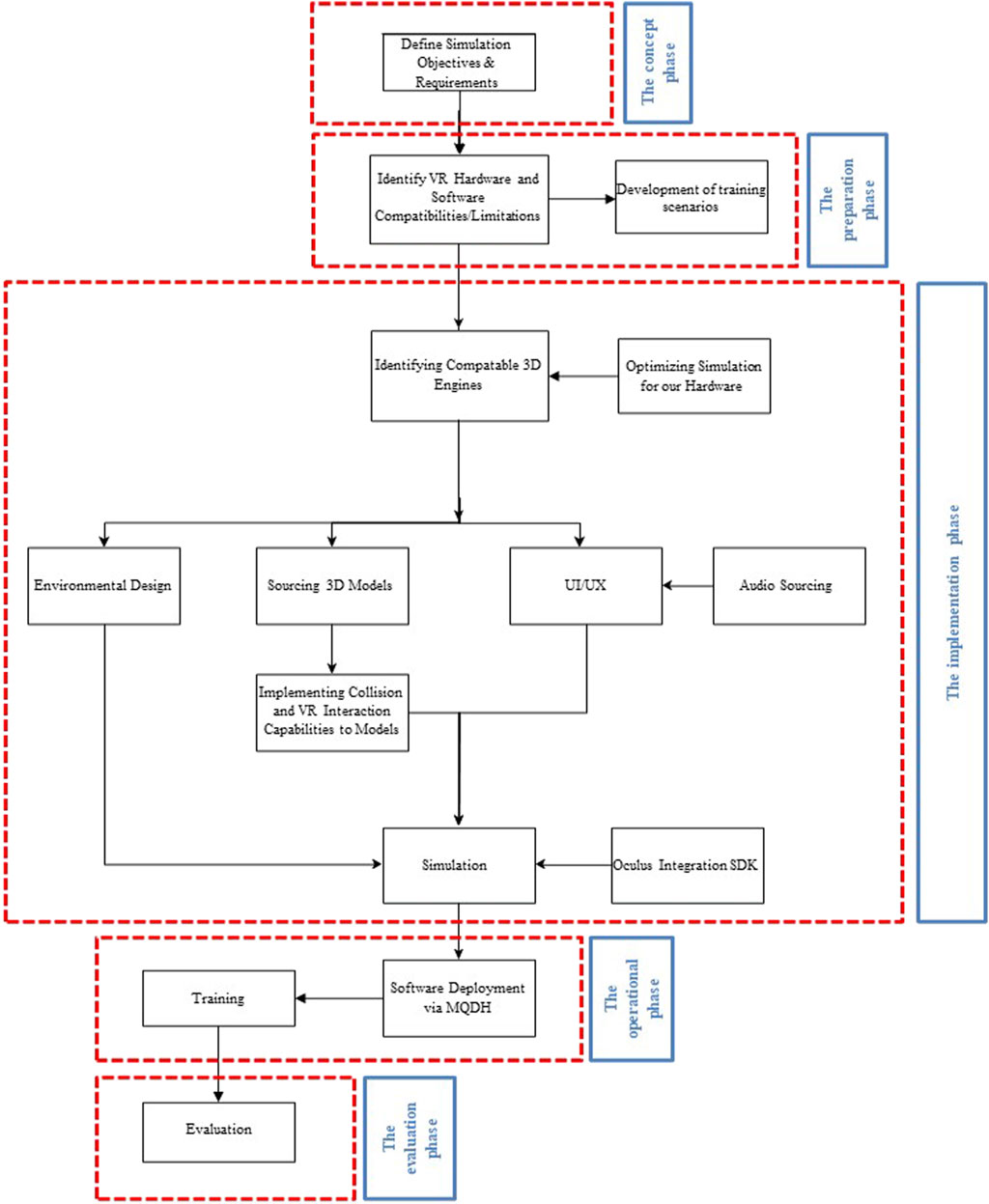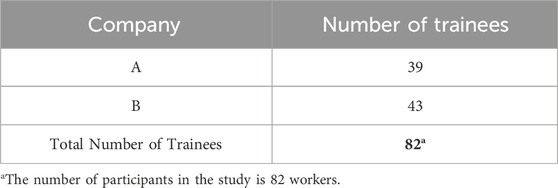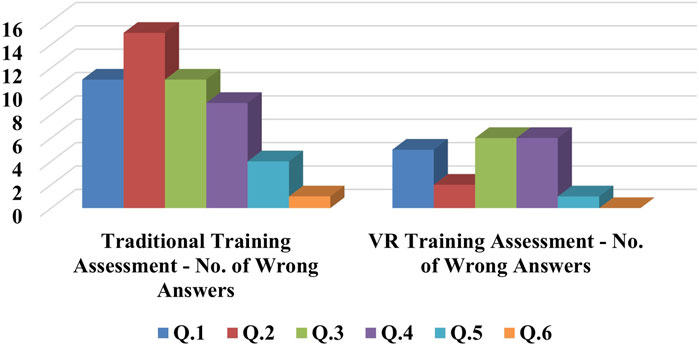- 1Department of Civil Engineering, Marshall University, Huntington, WV, United States
- 2Department of Computer Sciences and Electrical Engineering, Marshall University, Huntington, WV, United States
- 3Department of Mechanical and Industrial Engineering, Marshall University, Huntington, WV, United States
The construction industry is fraught with hazards, chief among them being the risk of falls from elevated positions, which are a leading cause of both fatalities and injuries among workers. Despite the prevalence of traditional safety training methods, their effectiveness in reducing fall risks remains limited. To solve this issue, this study proposes the adoption of interactive VR technologies to provide construction workers with immersive training experiences in the critical domain of fall safety. This approach not only ensures adherence to the Occupational Safety and Health Administration (OSHA) requirements but also leverages VR’s immersive capabilities to create a comprehensive and effective learning tool. To evaluate the proposed system’s efficacy, the researchers conducted an empirical assessment involving eighty-two construction workers from two small enterprises. Participants were divided into two groups: one receiving traditional training and the other undergoing VR-based instruction. Both groups underwent pre- and post-training evaluations comprising six targeted questions designed to measure the impact of each training method on their understanding and awareness of fall safety practices. The comparative analysis revealed no significant differences in baseline knowledge between the two groups prior to the training interventions. However, post-training evaluations demonstrated a notable improvement in the VR group, with a significant decrease in the number of incorrect responses, in stark contrast to the group subjected to traditional training methods. Statistical analysis further confirmed the superiority of VR training in enhancing participants’ knowledge. This was quantified by a p-value of 0.0016, indicating a high level of statistical significance well below the conventional threshold of 0.05. This study highlights the significant advantages of VR technology in construction safety training, demonstrating its superiority over traditional training methods in terms of knowledge retention and practical application. The results strongly support the wider adoption of VR in safety training, indicating its potential to enhance safety outcomes in the construction sector.
1 Introduction
Despite several endeavors to enhance safety, insufficient hazard recognition remains a significant obstacle in the construction industry. Falls are the main cause of both non-fatal and fatal accidents among construction workers globally, presenting a significant public health hazard (Anjum et al., 2022). According to the Bureau of Labor Statistics, from 2017 to 2021, the construction industry faced persistent safety challenges, evidenced by the number of fatal work injuries. Over these years, total fatalities hovered above the thousand mark, peaking in 2019 with 1,102 deaths before slightly declining to 1,015 by 2021. A considerable portion of these fatalities were due to falls, slips, and trips, with an alarming surge to 418 in 2019, after which numbers dipped but remained high. Specifically, falls to a lower level posed a significant threat, dominating this category and following a similar trend, with a stark increase in 2019, indicating that activities involving height continue to be particularly hazardous. In contrast, falls on the same level accounted for the fewest fatalities, yet even these lesser figures underscore the need for vigilant floor safety practices. Overall, the fluctuating but consistently high number of fatalities in the construction industry underscores the critical necessity for enhanced safety protocols and preventive strategies to address fall risks (USBLS, 2023).
In the realm of construction safety, VR has exhibited its effectiveness across a spectrum of applications. For instance, it has proven instrumental in enhancing safety training programs, providing a dynamic and engaging platform for educating workers about potential hazards and safety protocols (Teizer et al., 2013). VR-based safety training can offer a more memorable and impactful learning experience compared to traditional methods (Shi et al., 2018). Additionally, VR technology has been employed for hazard identification, offering workers and safety experts a platform to identify and address potential dangers before they manifest in reality (Perlman et al., 2014). This preventive approach can contribute to a safer work environment and reduce the occurrence of accidents. Furthermore, VR has been harnessed in the formulation of accident prevention initiatives within the construction industry (Guo et al., 2017). By simulating accident scenarios and their consequences, VR allows stakeholders to develop and test safety strategies in a risk-free virtual space.
Despite concerted efforts to enhance safety in the construction industry, fall hazards persist as a significant concern (Kaskutas et al., 2013). Despite the implementation of various safety protocols and procedures, traditional safety training methods have demonstrated limited effectiveness in adequately addressing and mitigating fall risks (Wang et al., 2018). To fill this gap, this paper proposes adopting an innovative virtual reality (VR) training system tailored specifically to address the challenges of fall prevention training. The rationale for employing virtual reality (VR) to address the knowledge gap in fall prevention training stems from several compelling factors. Firstly, VR offers a highly immersive and interactive environment, allowing trainees to engage in realistic scenarios that closely simulate real-world situations where falls commonly occur. This level of immersion enhances learning retention and skill acquisition compared to traditional training methods. Secondly, fall prevention training often requires repetitive practice of specific movements and scenarios to build muscle memory and reflexes. VR enables unlimited repetition without physical fatigue or risk of injury, enabling trainees to reinforce their skills effectively over time.
Overall, embracing cutting-edge VR technology through the proposed system aims to surpass the limitations of conventional methods, offering a more immersive and engaging learning experience. This shift towards VR-based training holds the potential to enhance the effectiveness of fall prevention training, thereby reducing workplace accidents and injuries. To support small and medium-sized enterprises (SMEs) in accessing this innovation, the development and implementation of the interactive VR training system are funded by OSHA and provided free of charge. SMEs stand to gain significantly from exploring external opportunities to test VR solutions, benefiting from the experience and resources available within the external innovation ecosystem, which they may lack independently.
2 Literature review
Scientists have used mixed reality (MR) and virtual reality (VR) techniques in the past several years for a variety of safety implementations, such as risk monitoring, training, and construction preparation. Using the following keywords in various countries, a literature study was conducted using Google Scholar to determine the knowledge gap: 1) Virtual Reality, 2) Construction Safety, 3) Training, and 4) Fall prevention. Below is a summary of the literature review’s findings:
Mora-Serrano et al. (2021) provide computerized tools based on VR experiences to support learning in occupational risk prevention. The proposal entails the creation of a procedure and resources that enable the replication of the exact situation in which the work will take place. This involves incorporating potential risks and incidents, scientifically establishing cause-effect connections, and integrating a narrative (storytelling) that imparts emotional significance to users. Finally, it demonstrates the establishment of a workflow that enables the agile construction of these virtual reality experiences for individual projects (Mora-Serrano et al., 2021).
According to Fernandez et al. (2022), it has been observed that existing risk prevention training courses do not adequately cater to the specific needs of individuals engaged in drilling operations. On the other hand, Fernandez’s research presents a novel approach where a 3D model of a geotechnical drilling machine is intricately incorporated into an immersive VR environment. Within this virtual setting, workers have the unique opportunity to replicate the actual movements and actions of the drilling machine. Furthermore, this innovative training system allows workers to simulate the complete geotechnical drilling process, enabling them to identify potential risks and proactively prevent accidents. Additionally, it offers an invaluable training avenue where less experienced workers can glean best practices for machine operation, drawing from the rich expertise of seasoned colleagues who have shared their real-world experiences (Fernandez et al., 2022).
Rokooei et al. (2023) developed a virtual reality (VR) module specifically designed for safety training in the roofing business. The VR application was developed using an agile methodology and a flow guided by industry experts. The results were examined using a quantitative approach, and several aspects of the VR module were investigated. The findings improve roofing professionals’ perceptions of the feasibility of incorporating VR as a supplementary training tool (Rokooei et al., 2023).
Chuah (2018) drew the conclusion that the adoption of extended reality (XR) technology, despite its promising potential, has not progressed as swiftly as anticipated. This slower pace can be attributed to the uncertainties surrounding the possibilities of XR. Furthermore, the interdisciplinary nature of XR applications has led to fragmented academic research and a lack of cohesive insights, which, in turn, has impeded practical implementation. In light of these challenges, Chuah embarked on an extensive literature review, meticulously identifying and analyzing 45 pertinent articles. The primary objective of this study is to identify and categorize the key factors that influence XR adoption, align them with existing reference models, and shed light on areas within XR research that warrant further exploration. Furthermore, the study outlines specific research directions aimed at bridging these gaps in our understanding of XR technology (Chuah, 2018).
Although VR training is promising, some researchers pointed out its associated challenges. For example, a study conducted in the UK by Badamasi et al. (2022) focused on adopting VR technologies in the AEC sector. Based on a survey, the study pinpointed significant barriers to VR adoption. The most crucial challenges were the high costs associated with VR devices, employees’ lack of VR skills, and the changes necessitated by VR adoption (Badamasi et al., 2022). Davila-Delgado et al. (2020) extended the investigation to identify relevant VR adoption factors in the UK. Employing focus groups and subsequent quantitative surveys, they ranked these factors in terms of their impact. The findings echoed the challenges that Badamasi et al. (2022) identified, with high costs, low maturity of VR technologies, skills gaps, and a general reluctance towards embracing new technologies being highlighted as key limiting factors (Davila-Delgado et al., 2020). Lastly, Noghabaei et al. (2020) conducted a comprehensive two-wave survey in the United States. Their study highlighted the most critical barriers to VR adoption within the AEC industry. Lack of financial resources and a notable absence of VR knowledge among top management and design teams emerged as prominent hurdles (Noghabaei et al., 2020). The current body of research indicates a significant lack of virtual reality (VR) equipment specifically designed to prevent falls in the construction industry. This study aims to address this gap by developing an engaging and highly effective virtual reality (VR) training system specifically tailored to reduce the likelihood of falls in construction projects. The main aim of this study is to narrow this disparity by creating realistic virtual reality situations that teach workers how to recognize potential fall hazards and implement precautionary measures. The primary objective of this project is to enhance safety by providing easily available and effective training options that cover a wide range of sectors.
3 Methodology
This research methodology includes developing VR system based on the Fall Prevention Fact Sheet that OSHA published in 2015 (OSHA, 2015). This training includes instruction about the safe use of ladders, scaffolds, and working on roofs. The advanced virtual reality (VR) technology fully immerses construction workers in authentic scenarios, including 1) safe use of ladders and scaffolding (Figure 1) and 2) roof safety and working near edges (Figure 2). Figures 1, 2 demonstrate that researchers have enhanced the immersive experience by creating a meticulously authentic virtual building setting. Scientists have acquired superior 3D models of authentic construction machinery, structures, vegetation, and landforms. The high degree of intricacy enhances the feeling of being there and involved in the simulation, resulting in an efficient teaching platform.
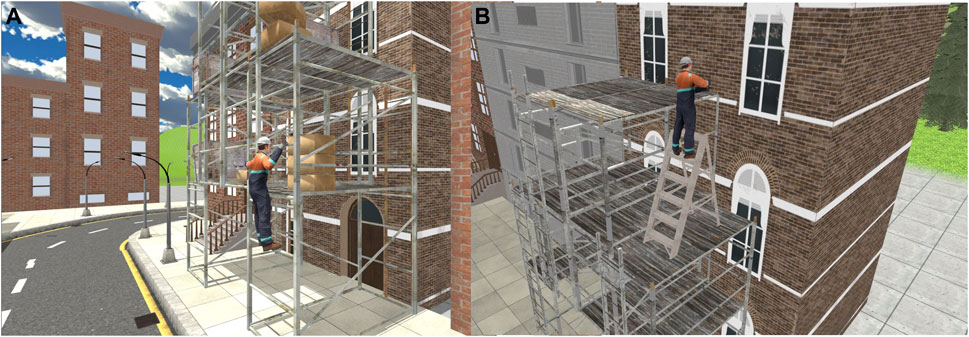
Figure 1. Climbing cross-braces are prohibited (A), and using a ladder on top of a scaffold is not permitted (B).
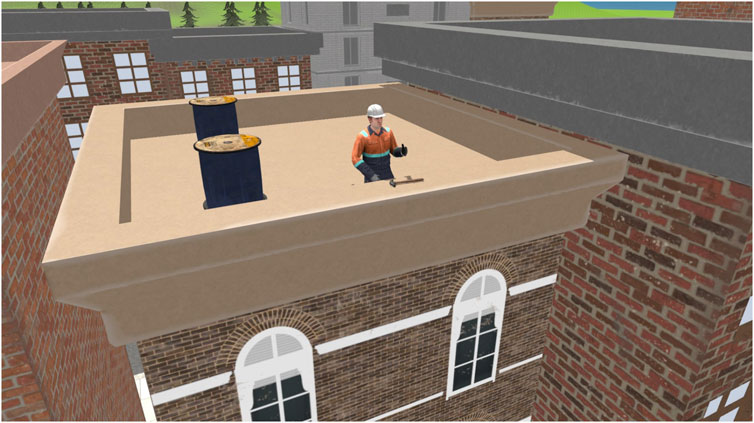
Figure 2. Standing less than 6 feet close to the roof’s edge without proper protection is prohibited.
According to Paszkiewicz et al. (2021), the methodology to develop a VR system comprises five phases as follows:
1. The concept phase defines the target solution, including assumptions and requirements.
2. The preparation phase details information for implementing the solution, including the training scenario and operating environment.
3. The implementation phase involves design, modeling, programming, and testing to ensure a coherent VR environment.
4. The operational phase provides training facilitated by qualified trainers and ongoing tests for effectiveness.
5. The evaluation phase collects feedback to evaluate training effectiveness, enhance the VR environment, and adapt to evolving needs.
Our proposed virtual reality (VR) system development follows the five steps above. The researcher identified precise simulation objectives and requirements in the concept phase to align with expected outcomes. In the preparation phase, the researchers thoroughly evaluate the compatibility and limitations of VR hardware and software technologies, considering their strengths and weaknesses. This phase also includes the development of two training scenarios, including 1) ensuring safety when working on scaffolding and 2) enhancing safety measures while working on roofs. In the implementation phase, the researchers carefully optimize the simulation to ensure smooth operation. This involves adjusting dynamic shadows, illumination, particle effects, rendering distance, and level of detail (LOD). In this phase, the researchers identified a compatible 3D engine framework that significantly impacts the simulation’s capabilities and performance. Then, they design the virtual environments, considering spatial configurations, interactive elements, and user objectives, prioritizing user-centric design for ease of use and accessibility. This includes crafting the simulation’s ambiance and atmosphere to create the desired tone and implementing collision detection and VR interaction capabilities, allowing users to interact with virtual objects accurately. Next, researchers designed a user-friendly interface with intuitive navigation, progress indicators, and audio prompts for an immersive experience. Finally, they connected the virtual reality headset to the VR world using the Oculus Interaction SDK. The operational phase includes software deployment. In this phase, the researchers deployed the software using Meta Quest Developer Hub (MQDH) for easy distribution and installation on user devices. Also, in this phase, the researchers train 82 steelworkers. These workers were selected because they worked in a steel plant where the work environment was hot on a daily basis. The final phase is the evaluation phase. In this phase, the workers were administered a survey before and after the training. More details about the evaluation phase are provided in Section 4: Evaluation and Assessment. Our VR application development methodology, depicted in Figure 3, is fitted for Meta Quest 2 and utilizes Unity3D within Visual Studio 2022 as the integrated development environment (IDE). We integrate Meta’s SDK to enable hand-tracking and spatial-tracking capabilities, enhancing user interactions. Hand-tracking adds a layer of realism by allowing users to manipulate objects in the virtual environment realistically, following the principles of physics. The research focuses on two training scenarios as follows:
3.1 Module 1: safe use of ladders and scaffolding
This module targets the safe and effective use of ladders and scaffolding equipment frequently used on construction sites and common sources of fall-related injuries. Through interactive VR scenarios, participants are guided through the steps to safely set up ladders or scaffolding. This includes checking for defects, ensuring stable footing, securing the base, and proper angling for ladders. It covers base assembly, platform construction, and guardrail installation for scaffolding. This part of the module is highly interactive, requiring participants to perform actions in the correct sequence and review safety checklists. Next, participants practice climbing, working from, and descending ladders or scaffolding. Emphasis is placed on maintaining three points of contact on ladders. For scaffolding, the focus is on ensuring even weight distribution, using guardrails, and not climbing cross-braces.
3.2 Module 2: roof safety and working near edges
This module aims to address the dangers associated with working on roofs and near edges, areas where falls are particularly prevalent and dangerous. The module begins with an interactive VR experience that guides participants through various roofing scenarios, illustrating common hazards such as unprotected roof edges, skylights, and weather conditions affecting stability. Participants interact with these elements to learn about their risks and the principles of risk assessment specific to roof work. Next, participants are placed in virtual environments where they must perform tasks near the edge of a roof. The VR system introduces a visual indicator when they come within 6 feet of an edge, triggering a tutorial on the importance of maintaining a safe working distance.
The proposed virtual reality (VR) system introduces groundbreaking features that significantly contribute to the current knowledge base. Notable enhancements have been made to Oculus integration libraries, enhancing user-friendliness and efficiency. Our primary focus is on advancing the object interaction and physics system, representing a significant leap forward. This system tracks user position and interactions within the virtual world, including actions like climbing a ladder or donning a hard helmet. It also precisely determines the user’s location in real-time, triggering actions such as playing audio prompts or displaying animations when specific spots in the environment are reached. This automation ensures a seamless training simulation experience, eliminating the need for instructor intervention and maintaining user immersion. These specialized capabilities required custom development tailored to our study’s unique demands.
Additionally, we’ve refined the teleportation system within the Oculus Integration library to align it closely with our project’s goals. Noteworthy is the deliberate limitation of user teleportation capabilities, guiding users through designated “hot spots” that provide direction and discourage deviations from the planned route. These zones are strategically placed for specific training modules, enhancing educational value and user-friendliness. We’ve also improved the Oculus Hand Tracking feature in the Oculus Integration for Unity library. This involved precise calibration of each finger and customized reactions to item collisions in the simulation. These modifications deliver a more accurate and engaging experience compared to the standard library offerings.
4 Evaluation and assessment
The efficacy of the proposed virtual reality (VR) technique was assessed through a series of training workshops conducted for 82 construction workers employed by two small-scale enterprises, as depicted in Table 1.
Participants from Company A engaged in a conventional training session that involved the use of PowerPoint slides and a lecture delivered by an OSHA-certified trainer from a third-party organization. Participants from Company B engaged in a virtual reality (VR) training session utilizing the interactive films generated in this study, as seen in Figure 4.
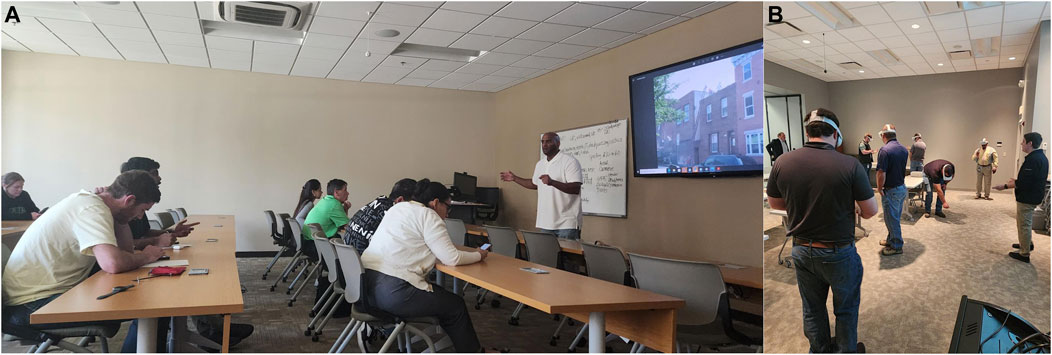
Figure 4. Company A participants took part in a traditional training session (A); and Company B participants took part in a VR training session (B).
Firm A and B participants were administered a survey before and after the training, consisting of six items. The pre-assessment exam served as a baseline for both experimental groups. Additionally, to assess any potential disparity in students’ prior knowledge between the two groups, a Mann-Whitney U-test was conducted, as detailed by Devore in 2020. The test results confirmed the absence of any statistically significant difference in students’ knowledge levels across the experimental groups before they commenced the learning sessions (p-value = 0.477 > 0.05).
The results of the post-assessment exam were analyzed to discern differences between the two learning approaches. Figure 5 demonstrates a significant decrease in incorrect responses across all questions after VR training compared to traditional methods. Additionally, a Mann-Whitney U-test was performed on post-test scores to assess the statistical significance of the instructional methods. The test revealed a significant disparity in student learning outcomes between VR instruction and conventional training, with a p-value of 0.0016.
5 Discussions and conclusion
The groundbreaking findings of this pioneering study, which advocates for the incorporation of interactive VR systems into fall prevention training within the construction industry, hold significant promise for broad application across diverse sectors and offer a valuable resource for academic researchers. The proposed VR system introduces innovative features, including enhanced Oculus integration for user-friendly interactions. It advances object interaction and physics simulations, accurately tracking user positions and actions like climbing or manipulating objects. Real-time location tracking triggers context-specific actions, eliminating the need for instructor intervention. Custom development tailored these capabilities to the study’s unique demands. Teleportation has been refined to guide users through designated areas, enhancing education. Oculus Hand Tracking improvements ensure accurate interactions, surpassing standard offerings. Results from other research on the use of immersive VR showed that participants using VR performed better than participants who used the traditional approach (Tea et al., 2022). For example, Wang et al. (2018) examine VR applications in Construction Engineering Education and Training (CEET), covering journal papers from 1997 to 2017. The review suggests future research directions, including the integration of VR with emerging educational paradigms and visualization technologies. These insights concur with this research finding and support our conclusion (Wang et al., 2018). Another article by Tan et al. (2022) explores the growing utilization of augmented and virtual reality (AR/VR) technologies in the architecture, engineering, and construction (AEC) industry, particularly in education and training. Through a systematic review of 82 relevant studies from Scopus and Web of Science, the current status of AR/VR in education and training within the AEC industry is analyzed. The findings reveal the benefits of AR/VR applications for education and training in the AEC industry. Additionally, the article identifies challenges and provides insights into future trends in AR/VR for education and training within the AEC industry (Tan et al., 2022). This work significantly contributes to the safety field by enhancing the theoretical comprehension of the efficacy of virtual reality (VR) training in preventing falls. The conclusion of the research based on the findings is summarized below:
• Empirical evidence from this research, supported by literature, confirms the superiority of VR training over traditional methods in improving safety and learning outcomes.
• This study marks a pivotal advancement in utilizing virtual reality (VR) for fall prevention training in the construction industry, indicating potential for broad application across various sectors.
A primary limitation of this research is the scope of VR technology’s applicability across different learning styles and the variation in user experience due to hardware limitations or personal discomfort with VR environments. Additionally, the study’s findings are based on controlled environments that may not fully capture the complexity and unpredictability of real-world construction sites, potentially limiting the direct applicability of the results to everyday work scenarios.
Future research should focus on addressing these limitations by exploring the inclusivity and adaptability of VR training tools across a broader demographic, taking into account different learning styles and potential accessibility issues. Studies could also investigate the long-term retention of skills and knowledge acquired through VR training, assessing the impact on workplace safety and efficiency over time. Moreover, integrating multisensory components and more advanced simulation technologies could enhance the realism and effectiveness of VR training, making it more representative of actual work conditions.
Overall, the results of this study signify substantial progress in enhancing occupational safety measures, namely, in the construction sector. By incorporating VR training, safety standards may be fundamentally transformed when workers are exposed to immersive and highly impactful learning experiences. Close collaboration between managers, researchers, and industry practitioners is essential to effectively tackle difficulties, capitalize on possibilities, and promote the wider implementation of VR safety training. By consistently conducting research and implementing new ideas, VR training can completely transform safety protocols in several sectors. This will result in the development of a more secure and knowledgeable workforce, while simultaneously decreasing the occurrence of workplace accidents and injuries.
Data availability statement
The original contributions presented in the study are included in the article/supplementary material, further inquiries can be directed to the corresponding author.
Ethics statement
Written informed consent was obtained from the individual(s) for the publication of any potentially identifiable images or data included in this article.
Author contributions
AA: Conceptualization, Funding acquisition, Methodology, Project administration, Resources, Supervision, Validation, Writing–original draft, Writing–review and editing. MM: Methodology, Software, Validation, Visualization, Writing–original draft. LD: Methodology, Software, Validation, Visualization, Writing–original draft. SC: Data curation, Formal Analysis, Investigation, Writing–original draft.
Funding
The authors declare that financial support was received for the research, authorship, and/or publication of this article. The research leading to the publication of this article was partially supported by the Occupational Safety and Health Administration (OSHA), grant number SH-39166-SH2.
Conflict of interest
The authors declare that the research was conducted in the absence of any commercial or financial relationships that could be construed as a potential conflict of interest.
Publisher’s note
All claims expressed in this article are solely those of the authors and do not necessarily represent those of their affiliated organizations, or those of the publisher, the editors and the reviewers. Any product that may be evaluated in this article, or claim that may be made by its manufacturer, is not guaranteed or endorsed by the publisher.
References
Anjum, S., Khan, N., Khalid, R., Khan, M., Lee, D., and Park, C. (2022). Fall prevention from ladders utilizing a deep learning-based height assessment method. IEEE Access 10, 36725–36742. doi:10.1109/ACCESS.2022.3164676
Badamasi, A. A., Aryal, K. R., Makarfi, U. U., and Dodo, M. (2022). Drivers and barriers of virtual reality adoption in UK AEC industry. Engineering, Construction and Architectural Management Journal 29, 1307–1318. doi:10.1108/ECAM-09-2020-0685
Chuah, S. H. W. (2018). Why and who will adopt extended reality technology? Literature review, synthesis, and future research agenda. SSRN Electronic Journal. doi:10.2139/ssrn.3300469
Davila-Delgado, J. M., Oyedele, L., Beach, T., and Demian, P. (2020). Augmented and virtual reality in construction: Drivers and limitations for industry adoption. Journal of Construction Engineering and Management 146, 04020079. doi:10.1061/(ASCE)CO.1943-7862.0001844
Fernandez, A., Muñoz-La Rivera, F., and Mora-Serrano, J. (2022). Prevention of occupational risks in geotechnical drilling works through virtual reality training. WIT Press. doi:10.2495/SAFE210121
Guo, H., Yu, Y., and Skitmore, M. (2017). Visualization technology-based construction safety management: A review. Automation in Construction 73, 135–144. doi:10.1016/j.autcon.2016.10.004
Jalo, H., Pirkkalainen, H., Torro, O., Pessot, E., Zangiacomi, A., and Tepljakov, A. (2022). Extended reality technologies in small and medium-sized European industrial companies: Level of awareness, diffusion and enablers of adoption. Virtual Reality 26, 1745–1761. doi:10.1007/s10055-022-00662-2
Kaskutas, V., Dale, A. M., Lipscomb, H., and Evanoff, B (2013). Fall prevention and safety communication training for foremen: Report of a pilot project designed to improve residential construction safety. Journal of Safety Research 44, 111–118. doi:10.1016/j.jsr.2012.08.020
Mora-Serrano, J., Muñoz-La Rivera, F., and Valero, I. (2021). Factors for the automation of the creation of virtual reality experiences to raise awareness of occupational hazards on construction sites. DOAJ Open Global Trusted 10 (1355), 1355. doi:10.3390/electronics10111355
Noghabaei, M., Heydarian, A., Balali, V., and Han, K. (2020). Trend analysis on adoption of virtual and augmented reality in the architecture, engineering, and construction industry. Data 5, 26–45. doi:10.3390/data5010026
Paszkiewicz, A., Salach, M., Dymora, P., Bolanowski, M., Budzik, G., and Kubiak, P. (2021). Methodology of implementing virtual reality in education for Industry 4.0. Sustainability 13, 5049. doi:10.3390/su13095049
Perlman, A., Sacks, R., and Barak, R (2014). Hazard recognition and risk perception in construction. Safety Science 64, 22–31. doi:10.1016/j.ssci.2013.11.019
Rokooei, S., Shojaei, A., Alvanchi, A., Azad, R., and Didehvar, N. (2023). Virtual reality application for construction safety training. Safety Science Journal 157, 105925. doi:10.1016/j.ssci.2022.105925
Shi, Y., Du, J., Ragan, E., Choi, K., and Ma, S. (2018). “Social influence on construction safety behaviors: A multi-user virtual reality experiment,” in Construction Research Congress 2018. doi:10.1061/9780784481288.018
Tan, Y., Xu, W., Li, S., and Chen, K. (2022). Augmented and virtual reality (AR/VR) for education and training in the AEC industry: A systematic review of research and applications. Buildings 12 (10), 1529. doi:10.3390/buildings12101529
Tea, S., Panuwatwanich, K., Ruthankoon, R., and Kaewmoracharoen, M. (2022). Multiuser immersive virtual reality application for real-time remote collaboration to enhance design review process in the social distancing era. Journal of Engineering, Design and Technology 20 (1), 281–298. doi:10.1108/jedt-12-2020-0500
Teizer, J., Cheng, T., and Fang, Y. (2013). Location tracking and data visualization technology to advance construction ironworkers’ education and training in safety and productivity. Automation in Construction 35, 53–68. doi:10.1016/j.autcon.2013.03.004
US Bureau of Labor Statistics (2023). Construction deaths due to falls, slips, and trips increased in 2021. Bureau of Labor Statistics. https://www.bls.gov/opub/ted/2023/construction-deaths-due-to-falls-slips-and-trips-increased-5-9-percent-in-2021.htm (Accessed October 11, 2023).
Keywords: fall prevention, construction safety, virtual reality, construction training, working at heights
Citation: Alzarrad A, Miller M, Durham L and Chowdhury S (2024) Revolutionizing construction safety: introducing a cutting-edge virtual reality interactive system for training US construction workers to mitigate fall hazards. Front. Built Environ. 10:1320175. doi: 10.3389/fbuil.2024.1320175
Received: 11 October 2023; Accepted: 18 March 2024;
Published: 03 April 2024.
Edited by:
Amir Mahdiyar, University of Science Malaysia, MalaysiaReviewed by:
Mohammad Mehdi Ghiai, University of Louisiana at Lafayette, United StatesSalman Riazi Mehdi Riazi, University of Science Malaysia (USM), Malaysia
Copyright © 2024 Alzarrad, Miller, Durham and Chowdhury. This is an open-access article distributed under the terms of the Creative Commons Attribution License (CC BY). The use, distribution or reproduction in other forums is permitted, provided the original author(s) and the copyright owner(s) are credited and that the original publication in this journal is cited, in accordance with accepted academic practice. No use, distribution or reproduction is permitted which does not comply with these terms.
*Correspondence: Ammar Alzarrad, YWx6YXJyYWRAbWFyc2hhbGwuZWR1
 Ammar Alzarrad
Ammar Alzarrad Matthew Miller
Matthew Miller Luke Durham
Luke Durham Sudipta Chowdhury3
Sudipta Chowdhury3